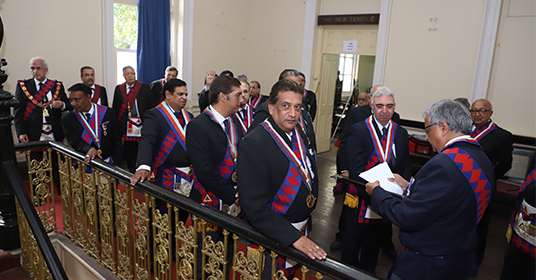Established in 1861, The District Grand Lodge of Bombay (DGL Bombay) has created a considerable geographical impact in India. It was, and is headquartered at Freemasons’ Hall, Damodardas Sukhadwala Marg, Fort, Mumbai 400001, India. Although, its members are spread across 23 Craft Lodges located in Mumbai, Pune, Goa, Nagpur, Jabalpur, Bilaspur, as well as in smaller cities or towns like Ahmednagar, Deolali, Bhusaval and Khadki.
DGL Bombay operates in the jurisdiction of the United Grand Lodge of England (UGLE), headquartered at Freemasons’ Hall, 60 Great Queen Street, LondonWC2B 5AZ, UK.
Freemasonry’s origin being lost in obscurity, numerous theories abound about how and when and where it came to be. Its roots, it is said, lie in ancient history.
The most plausible theory places its origin in Middle Ages Europe when church and cathedral building was pursued with great fervour. During this time an immense number of masons, working with stone, wood and other material were employed by the church builders. Not all were experts or masters in their field, and many were apprenticed to receive hands-on training on the job.
The Great Architect is not a specific Masonic god or an image that is a combination of all gods into one. Men of differing religions freely practice & pray together without offence being given to any of them. Freemasonry embraces all men who believe in God. Its membership includes Christians, Jews, Hindus, Sikhs, Muslims, Parsees and others.
The tercentenary of Grand Lodge in June 2017 was celebrated in style throughout the year, culminating with a special meeting of Grand Lodge in the Royal Albert Hall, which was presided over by the Grand Master, HRH The Duke of Kent KG.

Modern Freemasonry may be considered to be born during the inception of the Premier Grand Lodge, a Masonic body dedicated to the governance of Masonic activity in all lodges. This was created when three Lodges meeting in their respective taverns in London got together in 1717 to establish the same. The history of modern Freemasonry, or Masonry for short, has been very well documented and makes for very instructive, and often very entertaining, reading.
With time, British expatriates working in the colonies established Masonic Lodges where they were domiciled, and Masonry took off in a big way around the globe, particularly in America, where three quarters of the world’s Masons currently reside.


